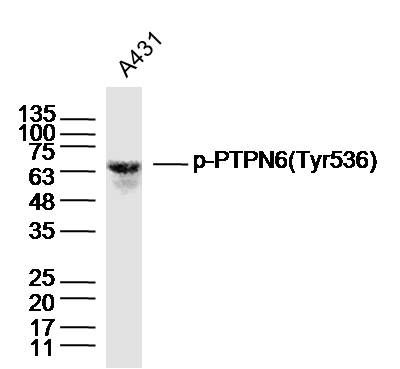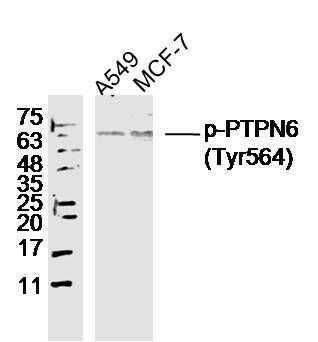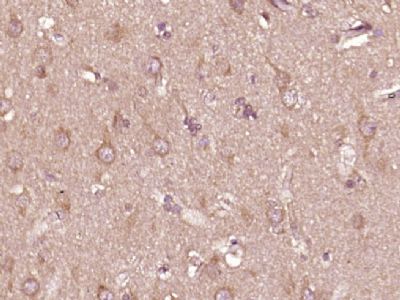
磷酸化蛋白酪氨酸磷酸酶1C抗体
产品名称: 磷酸化蛋白酪氨酸磷酸酶1C抗体
英文名称: phospho-PTPN6(Tyr564)
产品编号: hz-5577R
产品价格: null
产品产地: 中国/上海
品牌商标: HZbscience
更新时间: 2023-08-17T10:24:20
使用范围: IHC-P=1:400-800 IHC-F=1:400-800
上海沪震实业有限公司
- 联系人 : 鲍丽雯
- 地址 : 上海市闵行区闵北路88弄1-30号第22幢AQ136室
- 邮编 : 200612
- 所在区域 : 上海
- 电话 : 139****0749 点击查看
- 传真 : 点击查看
- 邮箱 : www.shzbio.net
- 二维码 : 点击查看
Rabbit Anti-phospho-PTPN6(Tyr564) antibody
| 产品编号 | hz-5577R |
| 英文名称 | phospho-PTPN6(Tyr564) |
| 中文名称 | 磷酸化蛋白酪氨酸磷酸酶1C抗体 |
| 别 名 | SHP-1(Phospho-Tyr536); PTPN6(phospho Y536); SHP1(phospho Y536); SHP1; 70 kda SHP 1L protein; 70 kda SHP1L protein; 70Z-SHP; EC 3.1.3.48; HCP; HCPH; Hematopoietic cell phosphatase; Hematopoietic cell protein tyrosine phosphatase; Hematopoietic cell protein-tyrosine phosphatase; HPTP 1C; HPTP1C; MGC124580; Protein tyrosine phosphatase 1C; Protein tyrosine phosphatase non receptor type 6; Protein tyrosine phosphatase SHP 1; Protein tyrosine phosphatase SHP1; Protein-tyrosine phosphatase 1C; Protein-tyrosine phosphatase SHP-1; PTN6_HUMAN; PTP 1C; PTP-1C; PTP1C; PTPN 6; PTPN6; SH PTP 1; SH PTP1; SH-PTP1; SHP 1; SHP 1L; SHP1L; SHPTP 1; SHPTP1; Tyrosine protein phosphatase non receptor type 6; Tyrosine-protein phosphatase non-receptor type 6. |
| 产品类型 | 磷酸化抗体 |
| 研究领域 | 肿瘤 免疫学 发育生物学 信号转导 转录调节因子 激酶和磷酸酶 |
| 抗体来源 | Rabbit |
| 克隆类型 | Polyclonal |
| 交叉反应 | Human, Dog, Horse, |
| 产品应用 | IHC-P=1:400-800 IHC-F=1:400-800 (石蜡切片需做抗原修复) not yet tested in other applications. optimal dilutions/concentrations should be determined by the end user. |
| 分 子 量 | 65kDa |
| 细胞定位 | 细胞核 细胞浆 |
| 性 状 | Lyophilized or Liquid |
| 浓 度 | 1mg/ml |
| 免 疫 原 | KLH conjugated Synthesised phosphopeptide derived from human PTPN6 around the phosphorylation site of Tyr536 [SE(p-Y)GN]:SE(p-Y)GN |
| 亚 型 | IgG |
| 纯化方法 | affinity purified by Protein A |
| 储 存 液 | 0.01M TBS(pH7.4) with 1% BSA, 0.03% Proclin300 and 50% Glycerol. |
| 保存条件 | Store at -20 °C for one year. Avoid repeated freeze/thaw cycles. The lyophilized antibody is stable at room temperature for at least one month and for greater than a year when kept at -20°C. When reconstituted in sterile pH 7.4 0.01M PBS or diluent of antibody the antibody is stable for at least two weeks at 2-4 °C. |
| PubMed | PubMed |
| 产品介绍 | background: The protein encoded by this gene is a member of the protein tyrosine phosphatase (PTP) family. PTPs are known to be signaling molecules that regulate a variety of cellular processes including cell growth, differentiation, mitotic cycle, and oncogenic transformation. N-terminal part of this PTP contains two tandem Src homolog (SH2) domains, which act as protein phospho-tyrosine binding domains, and mediate the interaction of this PTP with its substrates. This PTP is expressed primarily in hematopoietic cells, and functions as an important regulator of multiple signaling pathways in hematopoietic cells. This PTP has been shown to interact with, and dephosphorylate a wide spectrum of phospho-proteins involved in hematopoietic cell signaling. Multiple alternatively spliced variants of this gene, which encode distinct isoforms, have been reported. [provided by RefSeq, Jul 2008] Function: Modulates signaling by tyrosine phosphorylated cell surface receptors such as KIT and the EGF receptor/EGFR. The SH2 regions may interact with other cellular components to modulate its own phosphatase activity against interacting substrates. Together with MTUS1, induces UBE2V2 expression upon angiotensin II stimulation. Plays a key role in hematopoiesis. Subunit: Monomer. Interacts with MTUS1. Interacts with MILR1 (tyrosine-phosphorylated). Interacts with KIT. Binds PTPNS1, LILRB1 and LILRB2. Interacts with FCRL2, FCRL3, FCRL4, CD300LF, CDK2 and CD84. Interacts with KIR2DL1; the interaction is enhanced by ARRB2. Interacts (via SH2 1 domain) with ROS1; the interaction is direct and promotes ROS1 dephosphorylation. Interacts with EGFR; inhibits EGFR-dependent activation of MAPK/ERK. Interacts with LYN. Interacts with the tyrosine phosphorylated form of PDPK1. Subcellular Location: Cytoplasm. Nucleus. Note=In neurons, translocates into the nucleus after treatment with angiotensin II. Shuttles between the cytoplasm and nucleus via its association with PDPK1. Tissue Specificity: Isoform 1 is expressed in hematopoietic cells. Isoform 2 is expressed in non-hematopoietic cells. Post-translational modifications: Phosphorylated on tyrosine residues. Binding of KITLG/SCF to KIT increases tyrosine phosphorylation. Phosphorylation at Tyr-564 enhances phosphatase activity. Similarity: Belongs to the protein-tyrosine phosphatase family. Non-receptor class 2 subfamily. Contains 2 SH2 domains. Contains 1 tyrosine-protein phosphatase domain. Gene ID: 5777 Database links: Entrez Gene: 5777 Human Entrez Gene: 15170 Mouse Entrez Gene: 116689 Rat Omim: 176883 Human SwissProt: P29350 Human SwissProt: P29351 Mouse SwissProt: P81718 Rat Unigene: 63489 Human Unigene: 271799 Mouse Unigene: 18985 Rat Important Note: This product as supplied is intended for research use only, not for use in human, therapeutic or diagnostic applications. |
| 产品图片 |
 Sample: A431 Cell (Human) Lysate at 40 ug
Primary: Anti-phospho-PTPN6(Tyr564)(bs-5577R)at 1/300 dilution Secondary: IRDye800CW Goat Anti-Rabbit IgG at 1/20000 dilution Predicted band size: 65kD Observed band size: 65kD  Sample:
A549 Cell (Human) Lysate at 40 ug MCF-7 Cell (Human) Lysate at 40 ug Primary: Anti- phospho-PTPN6(Tyr564) (bs-5577R) at 1/300 dilution Secondary: IRDye800CW Goat Anti-Rabbit IgG at 1/20000 dilution Predicted band size: 65 kD Observed band size: 65 kD  Paraformaldehyde-fixed, paraffin embedded (Human glioma); Antigen retrieval by boiling in sodium citrate buffer (pH6.0) for 15min; Block endogenous peroxidase by 3% hydrogen peroxide for 20 minutes; Blocking buffer (normal goat serum) at 37°C for 30min; Antibody incubation with (phospho-PTPN6(Tyr564)) Polyclonal Antibody, Unconjugated (bs-5577R) at 1:400 overnight at 4°C, followed by operating according to SP Kit(Rabbit) (sp-0023) instructionsand DAB staining
|
